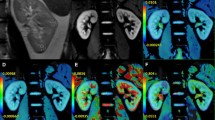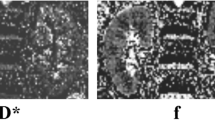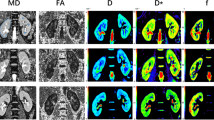Abstract
Objective
The purpose of the study was to examine differences in kidney intravoxel incoherent motion diffusion-weighted imaging (IVIM-DWI) parameters in early-stage diabetic patients versus healthy controls.
Materials and methods
Nineteen type 2 diabetic patients (group A) with a urinary albumin-to-creatinine ratio (ACR) < 30 mg/g and an estimated glomerular filtration rate (eGFR) of 80–120 mL/(min 1.73 m2) and twelve healthy volunteers (group B) were recruited. Kidneys were scanned with 1.5-Tesla IVIM-DWI. Nine b values (0, 50, 100, 150, 200, 300, 400, 600, and 800 s/mm2) were used. The parameters derived from IVIM-DWI were calculated for each kidney by two radiologists and included the perfusion fraction (f), diffusion coefficient (D), and pseudo-diffusion coefficient (D*). The mean values of f, D, and D* were calculated by selecting multiple regions of interest in the kidney. The diagnostic performance of the f, D, and D* values for the diagnosis of early diabetic kidney changes was determined by receiver operating characteristic analysis. Three radiologists independently measured the parameters derived from IVIM-DWI in the two groups by free-hand placing regions of interest, and the interclass coefficients (ICCs) were analyzed by SPSS.16.0 software.
Results
The f values of the kidneys were significantly higher in diabetic patients than in healthy volunteers. The D value of the kidneys was significantly lower in diabetic patients than in healthy volunteers. No significant differences in the D* values of the kidneys were observed between diabetic patients and healthy volunteers. The D values of the right kidneys were significantly higher than those of the left kidneys in both groups. The results of the receiver operating characteristic analysis were as follows: left kidney—f value AUC = 0.650 (cutoff point ≥ 27.49%) and D value AUC = 0.752 (cutoff point ≤ 1.68 × 10−3 mm2/s); and right kidney—f value AUC = 0.650 (cutoff point ≥ 28.24%) and D value AUC = 0.752 (cutoff point ≤ 1.81 × 10−3 mm2/s). The diagnostic performance of the D* value was very low (AUC < 0.6). No significant differences were present between the areas under the curves of the f and D values (P > 0.05). The ICCs of the f value and D value were between 0.637 and 0.827. The ICC of the D* value was less than 0.3.
Conclusion
The results of our study suggest that changes in kidneys detected by IVIM-DWI may serve as indicators of early diabetic kidney disease.


Similar content being viewed by others
References
National Kidney Foundation (2012) KDOQI clinical practice guideline for diabetes and CKD: 2012 update. Am J Kidney Dis 60(5):850–886
Herrmann J, Ittrich H, Kaul MG, et al. (2017) Functional assessment of the kidneys in a 10 month-old child with renal artery stenosis by intravoxel incoherent motion. Nephrology 22:257–260
Notohamiprodjo M, Chandarana H, Mikheev A, et al. (2015) Combined intravoxel incoherent motion and diffusion tensor imaging of renal diffusion and flow anisotropy. Magnetic Resonance in Medicine 73(4):1526–1532
Poynton CB, Lee MM, Li Y, et al. (2017) Intravoxel incoherent motion analysis of renal allograft diffusion with clinical and histopathological correlation in pediatric kidney transplant patients: a preliminary cross-sectional observational study. Pediatr Transplant 26(6):e12996
Ren T, C-l Wen, L-h Chen, et al. (2016) Evaluation of renal allografts function early after transplantation using intravoxel incoherent motion and arterial spin labeling MRI. Magn Reson Imaging 34(7):908–914
Ding Y, Zeng M, Rao S, et al. (2016) Comparison of biexponential and monoexponential model of diffusion-weighted imaging for distinguishing between common renal cell carcinoma and fat poor angiomyolipoma. Korean J Radiol 17(6):853–863
Rheinheimer S, Stieltjes B, Schneider F, et al. (2012) Investigation of renal lesions by diffusion-weighted magnetic resonance imaging applying intravoxel incoherent motion-derived parameters–initial experience. Eur J Radiol 81(3):e310–e316
Chandarana H, Kang SK, Wong S, et al. (2012) Diffusion-weighted intravoxel incoherent motion imaging of renal tumors with histopathologic correlation. Invest Radiol 47(12):688–696
Pugliese G, Solini A, Bonora E, et al. (2011) The Chronic Kidney Disease Epidemiology Collaboration (CKD-EPI) equation provides a better definition of cardiovascular burden associated with CKD than the Modification of Diet in Renal Disease (MDRD) Study formula in subjects with type 2 diabetes. Atherosclerosis 218(1):194–199
Le Bihan DBE, Lallemand D, Grenier P, Cabanis E, Laval-Jeantet M (1986) MR imaging of intravoxel incoherent motions: application to diffusion and perfusion in neurologic disorders. Radiology 161:401–407
Cakmak P, Yagci AB, Dursun B, Herek D, Fenkci SM (2014) Renal diffusion-weighted imaging in diabetic nephropathy: correlation with clinical stages of disease. Diagn Interv Radiol 20(5):374–378
Bane O, Wagner M, Zhang JL, et al. (2016) Assessment of renal function using intravoxel incoherent motion diffusion-weighted imaging and dynamic contrast-enhanced MRI. J Magn Reson Imaging 44(2):317–326
Carbone SF, Gaggioli E, Ricci V, et al. (2007) Diffusion-weighted magnetic resonance imaging in the evaluation of renal function: a preliminary study. Radiol med 112:1201–1210
Emre T, Kilickesmez O, Buker A, et al. (2016) Renal function and diffusion-weighted imaging: a new method to diagnose kidney failure before losing half function. Radiol Med 121(3):163–172
Heusch P, Wittsack H-J, Pentang G, et al. (2013) Biexponential analysis of diffusion-weighted imaging: comparison of three different calculation methods in transplanted kidneys. Acta Radiol 54(10):1210–1217
Ichikawa S, Motosugi U, Ichikawa T, et al. (2013) Intravoxel incoherent motion imaging of the kidney: alterations in diffusion and perfusion in patients with renal dysfunction. Magn Reson Imaging 31(3):414–417
Li Q, Li J, Zhang L, et al. (2014) Diffusion-weighted imaging in assessing renal pathology of chronic kidney disease: a preliminary clinical study. Eur J Radiol 83:756–762
Thoeny HC, De Keyzer F, Oyen RH, Peeters RR (2005) Diffusion-weighted MR imaging of kidneys in healthy volunteers and patients with parenchymal diseases: initial experience. Radiology 235(3):911–917
Chen X, Xiao W, Li X, et al. (2014) In vivo evaluation of renal function using diffusion weighted imaging and diffusion tensor imaging in type 2 diabetics with normoalbuminuria versus microalbuminuria. Front Med 8(4):471–476
Le Bihan D (2008) Intravoxel incoherent motion perfusion mr imaging: a wake-up call. Radiology 249(3):748–752
Sigmund EE, Vivier PH, Sui D, et al. (2012) Intravoxel incoherent motion and diffusion-tensor imaging in renal tissue under hydration and furosemide flow challenges. Radiology 263(3):758–769
Ding Y, Miao X, Li R, et al. (2016) Intravoxel incoherent motion diffusion weighted imaging of normal adult kidney. J PractRadiol 32(4):71–78
Jerome NP, Orton MR, D’Arcy JA, et al. (2014) Comparison of free-breathing with navigator-controlled acquisition regimes in abdominal diffusion-weighted magnetic resonance images: effect on ADC and IVIM statistics. J Magn Reson Imaging 39(1):235–240
Pan J, Zhang H, Man F, et al. (2017) Measurement and scan reproducibility of parameters of intravoxel incoherent motion in renal tumor and normal renal parenchyma: a preliminary research at 3.0T MR. Abdom Radiol
Barbieri S, Donati OF, Froehlich JM, Thoeny HC (2016) Comparison of intravoxel incoherent motion parameters across MR imagers and field strengths: evaluation in upper abdominal organs. Radiology 279(3):784–794
Author information
Authors and Affiliations
Corresponding author
Ethics declarations
Funding
No funding was received for this study.
Conflict of interest
All authors declare that they have no conflicts of interest.
Informed consent
Informed consent was obtained from all participants included in the study.
Rights and permissions
About this article
Cite this article
Deng, Y., Yang, B., Peng, Y. et al. Use of intravoxel incoherent motion diffusion-weighted imaging to detect early changes in diabetic kidneys. Abdom Radiol 43, 2728–2733 (2018). https://doi.org/10.1007/s00261-018-1521-4
Published:
Issue Date:
DOI: https://doi.org/10.1007/s00261-018-1521-4




